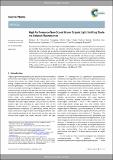High performance non-doped green organic light emitting diode via delayed fluorescence
Abstract
Non-doped, delayed fluorescence organic light-emitting diodes (OLEDs) provide a route to high performance devices and simplified device fabrication. Here, two ambipolar anthracene derivatives containing a hole-transporting di-p-tolylamine and a carbazole and an electron-transporting phosphine oxide moiety are rationally designed and synthesized. The thermal and optoelectronic properties were investigated and the neat films of these compounds show high photoluminescence quantum yields of 84–87%. Non-doped OLEDs with these luminogens exhibit green emission at ∼545 nm and an EQEmax of over 7.2% due to the delayed fluorescence resulting from triplet–triplet annihilation (TTA). The devices show a high luminance of over 104 400 cd m−2. Power efficiency and current efficiency maxima are up to 23.0 lm W−1 and 28.3 cd A−1, respectively. Moreover, the devices show very low efficiency roll-off and retain 90% of the maximum efficiency even at 20 000 cd m−2. When combined with a thermally activated delayed fluorescent (TADF) assistant dopant, the green-emitting OLEDs show a high EQEmax of 17.8%.
Citation
Sk , B , Thangaraji , V , Yadav , N , Nanda , G P , Das , S , Gandeepan , P , Zysman-Colman , E & Rajamalli , P 2021 , ' High performance non-doped green organic light emitting diode via delayed fluorescence ' , Journal of Materials Chemistry C , vol. 2021 , no. 43 , pp. 15583-15590 . https://doi.org/10.1039/D1TC03849D
Publication
Journal of Materials Chemistry C
Status
Peer reviewed
ISSN
2050-7526Type
Journal article
Description
Funding: P. G. thanks the Science & Engineering Research Board (SERB), India, for the Start-up Research Grant (SRG) (Grant No: SRG/2020/000161). E.Z-C. thanks the Engineering and Physical Sciences Research Council (EPSRC) EP/P010482/1 and Royal Society Leverhulme Trust Senior Research fellow (SRF\R1\20108 for support. P. R. thanks the Indian Institute of Science (IISc) for generous financial support and the Science & Engineering Research Board (SERB), India, for the SERB-Power Grant (SPG) (Grant No: SPG/2020/000107). B.S. thank IISc for the C. V. Raman Fellowship under the Institute of Eminence (IoE).Collections
Items in the St Andrews Research Repository are protected by copyright, with all rights reserved, unless otherwise indicated.

